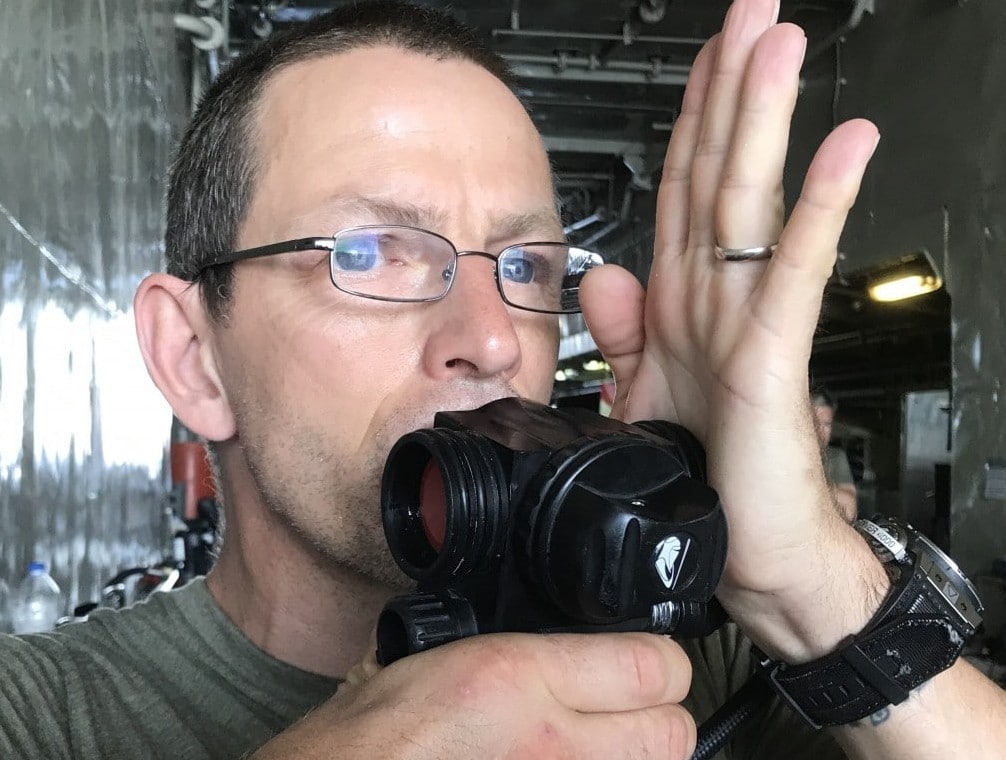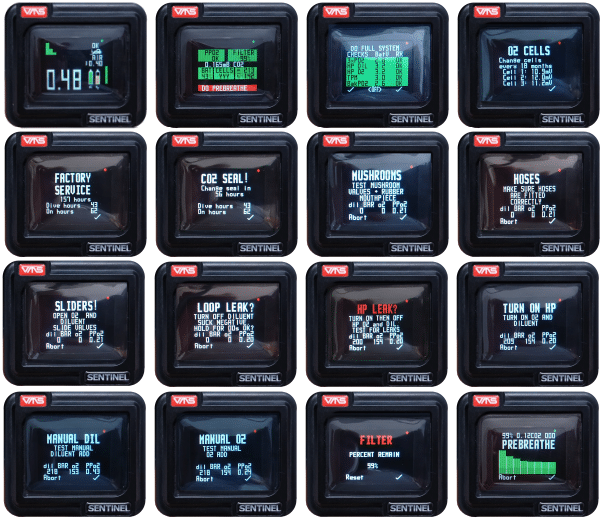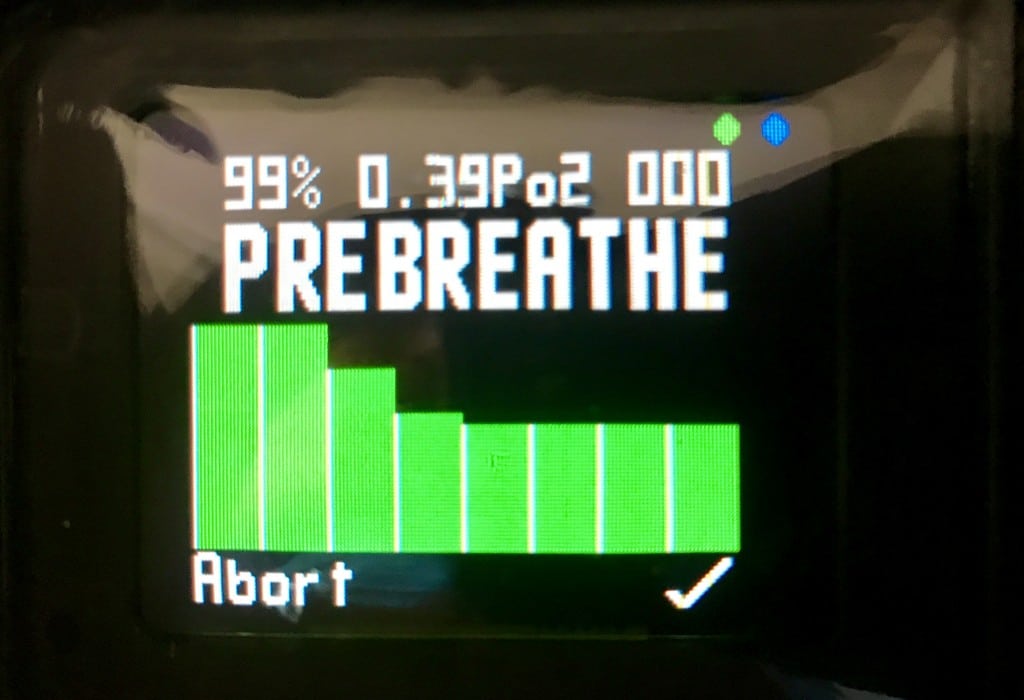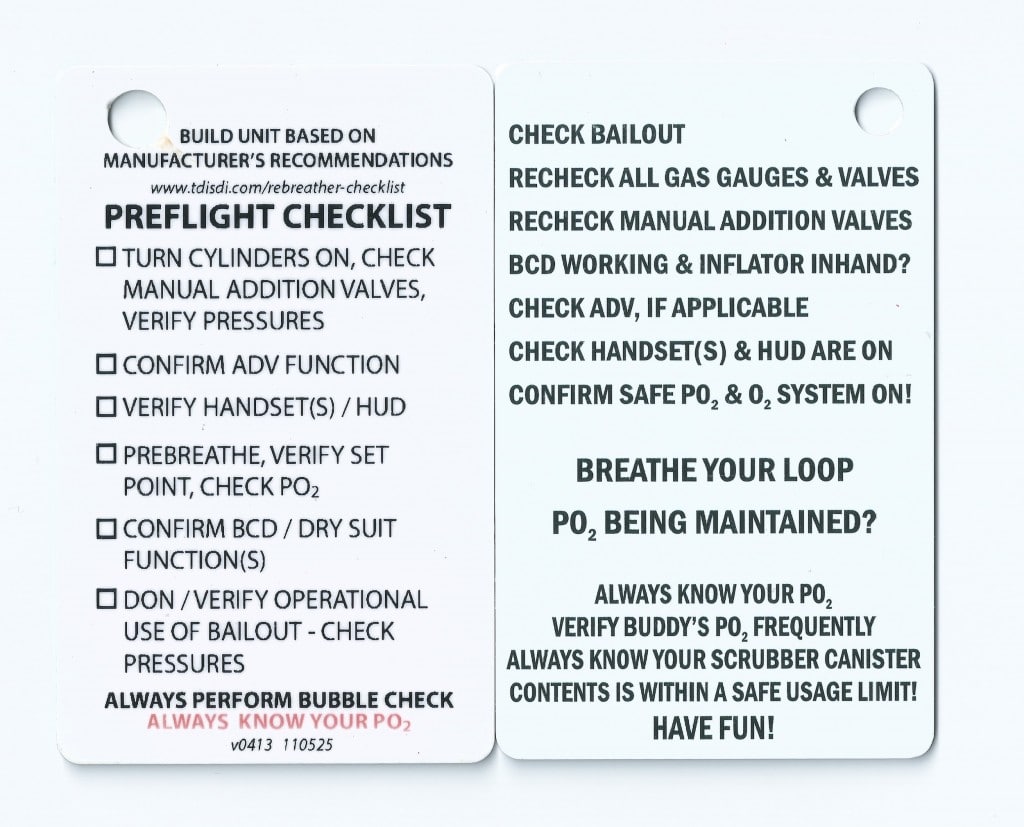News
Rebreather Pre-Dive Checks

The following is a discussion and review of the subject of Pre Dive checks when diving rebreathers – a much discussed, varied and often controversial matter!
When we first learn to dive, the concept of a buddy check, pre dive check or safety drill is installed in us as a means to make the dive safer by spotting potential problems before they can manifest and potentially evolve into accidents.
This is not a procedure limited to diving, it is extremely common in the Aviation, Aerospace and military communities, but to bring it closer to home it is present when we drive a car. When we drive a simple, mainly mechanical, car we are aware of the pre drive steps of checking the coolant level, the tyre pressures and the oil level and then adjusting the seat, wing and rear view mirrors to the individual driver. In a more modern, computer controlled car, many of these checks may be completed by the control system and communicated to the driver via dash board instrumentation and at the high end, even the seat and mirror settings can be altered to individual drivers with the push of a button. What is most common is a combination of automated computer generated checks and manual human checks; either way we are assured of the functionality of the vehicle before heading out on the road.
With rebreather technology the source of the pre dive check sequence and method could come from a variety of places. The manufacturer of the specific rebreather, a training agency that teach a specific rebreather, a generic training agency rebreather check list to suit all rebreathers and a learnt acronym to prompt the required checks.
Of course it would be best if available to use the specific rebreather check list or system supplied by the manufacturer.
Within the above there are different ways to complete checks:
- A written check list
- A check list acronym – e.g a common rebreather check list reminder is the acronym of F.L.A.G.S.
- Flow
- Loop
- Analyse
- Gauges
- Stack/Sensors
- Electronic check lists within the rebreathers display

- Electronic check lists that analyse data from the actual components of the rebreather.

What should be checked?
Pre-Assembly
Mushroom (One Way) Valves. The one way check valves within the Mouthpiece assembly that ensure the gas flows around the rebreather in a single correct direction should be tested to ensure they open with and close against FLOW.

The Oxygen, Diluent, Single supply gas and all bailout cylinders for the planned dive should be ANALYSED.
The absorbent canister (STACK) should be either re-packed or replaced. Or the used time of a previously used canister should be noted and the remaining time available compared to the dive plan.
Pre-Dive
There are as many pre dive check sequences as there are rebreathers, in fact many more! So for initial discussion of the steps of pre dive checks we will here use the acronym FLAGS as a starting point. Although not exhaustive if the printed check sheets or on screen check prompts of most of the currently available rebreathers are reviewed all steps within them can be classified under one of the following prompt words:
F – FLOW
Ambient pressure gas flow around the rebreather in a single correct direction. Tested with the Mushroom (One Way) valve check as part of Pre Assembly. This should be tested prior to each dive as stray granules of absorbent etc could compromise a Mushroom Valve.
High pressure and intermediate pressure gas flow around the rebreather. Slowly turn on the cylinder valves and then add Diluent and Oxygen manually, inflate and check dumps on BCD/wing, check that the ADV and BOV function and ensure the solenoid can inject oxygen where applicable to each specific type of rebreather.
L – LOOP
Conduct a negative loop test and a positive loop test where appropriate to each style of rebreather.
A negative test is conducted on a completely assembled rebreather by placing the mouthpiece in the rebreather or closed circuit position and breathing in through the mouth (To empty the loop) and out through the nose until the loop is empty and then closing the mouthpiece. A suitable period of time (A minimum of 1 minute) is allowed to pass and the rebreather should maintain that negative i.e. not leak air into to rebreather.
Indications of a good negative can include, crushed breathing hoses, ADV diaphragm remaining concave or in, a lower PO2 than ambient (e.g. Pre negative mouthpiece open PO2 0.21, during negative mouthpiece closed 0.19) and a strong ‘gasp’ or sucking sound when opening the mouthpiece at the end of the check.
A positive test is conducted on a completely assembled rebreather by placing the mouthpiece in the rebreather or closed circuit position and breathing in through the nose and out through the mouth until the loop is full and then closing the mouthpiece. A suitable period of time (A minimum of 1 minute) is allowed to pass and the rebreather should maintain that positive i.e. not leak air out of rebreather.
Indications of a good positive can include rigid inflated counter lungs.
A – ANALYSE
The Rebreather although containing Oxygen sensors must not be used to analyse the gases used within the rebreather.
All gases, Oxygen, Diluent and all bailouts should be analysed and labeled prior to being assembled into the rebreather or as bailouts with an Oxygen or where required an Oxygen/Helium analyser.
Many rebreathers are calibrated by flushing them completely or flushing a sensing chamber where the sensors sit with Oxygen at Ambient pressure, if this were completed with a gas supply other than specified (i.e. Oxygen) then the calibration would be inaccurate and therefore the PO2 incorrect during the dive.
G – GAUGES
Test the contents of all required cylinders, Oxygen, Diluent and all required bailout and check for leaks.
Turn on (Slowly) cylinder valves and note the reading of pressure.
Turn off cylinder valves and leave off for 1 minute.
Check contents pressure has not dropped (If the pressure has dropped there is an HP or IP leak to be located and resolved)
S – STACK / SENSORS
The rebreather should be tested for basic function by the Pre Breathe detailed below.
The purpose of this check is to watch the 3 sensor outputs for stabilisation, correct reading and change on prompt i.e. whist breathing add Oxygen and note a rise in PO2 and then add Diluent and note a drop in PO2 from set point.
If fitted during the Pre Breathe a Carbon Dioxide sensor can be monitored for a rising figure.
Again if fitted on the specific rebreather a thermal activity monitor ‘Temp Stick’ can be monitored to ascertain the exothermic reaction of the sofnolime absorbing Carbon Dioxide causing thermal sensors within the stack to register a rise in temperature.
Pre-Breathe
The fully assembled Pre Dive checked rebreather should be breathed for an adequate time to assure the user of systems functionality.
This is the period when the above Stack/Sensors tests are performed.
Current research would indicate that a part used, over used, poorly packed, incorrectly fitted or even absent stack may not give enough signs or symptoms of Hypercapnia during a 3-5 minute Pre Breathe to ensure a diver notices and considers the rebreather unfit for use.
Quick Pre Jump Confirmation
Many training agencies provide Pre Jump quick check prompt cards that can be attached to the Rebreather.

Steps on these include but are not limited to:
- Cylinder valves fully open on Oxygen, Diluent, Single supply gas and bailout?
- Electronics on and safe breathable PO2 displayed?
- BCD inflated?
- Mouthpiece in mouth and in rebreather position?
These Pre Jump checks are NOT considered a full Pre Dive check and are in no way meant to replace full Pre assembly, Pre Dive and Pre Dive checks. The Pre Jump is intended to be used in addition to normal checks as a last check just prior to water entry.
Find out more about Phil at www.philshorttechnical.co.uk.
Gear News
Introducing the TR-80, IR-50 and CS-30 Regulators from DYNAMICNORD

Whether you are a beginner or a professional diver – with the three new main regulators from DYNAMICNORD, everyone will find their favourite regulator. They all look super stylish.
Excellent performance with the TR-80
Quality and performance are the be-all and end-all for regulators. It is not for nothing that the TR stands for Tec Reg. The innovative design of the TR-80 guarantees absolute reliability – even in ice-cold waters.

Perfect breathing effort at 0.8 J/l / certified for diving in waters below 10 degrees / structural design made of solid brass for best cold protection / membrane-compensated design with dry seal of the first stage / reduced exhalation effort thanks to optimized exhalation membrane and bubble deflector / adjustable Venturi (dive/predive) and adjustment knob for individual inhalation comfort / innovative design of the front cover prevents free-flow in strong currents or when diving with scooters / design made of sandblasted brass, matt chrome finish / 2 HP and 4 LP outlets / mouthpiece made of high-quality, anti-allergic silicone for maximum comfort.


Amazing underwater adventures with the IR-50
The IR-50 is the top regulator for advanced and experienced divers. Natural breathing is the essence of this regulator.

Ideal breathing effort at 0.8 J/l /certified for diving in waters below 10 degrees / compensated membrane / adjustable venturi (dive/predive) and adjustment knob for individual inhalation comfort/ outlet valve and deflector for minimum exhalation effort and reduction of bubbles on the face / design made of sandblasted brass, matt chrome finish / 2 HP and 4 NP outlets / mouthpiece made of high-quality, anti-allergic silicone for maximum comfort.


The Workhorse – our CS-30
For diving centres and diving beginners – the workhorse stands for strong construction, reliability and robustness. Perfect for your training.

Optimal breathing effort at 0.8 J/l /recommended for diving in waters above 10 degrees / non-compensated piston / adjustable venturi (dive/predive) / outlet valve and deflector for minimum exhalation effort and reduction of bubbles on the face / design made of sandblasted brass, matt chrome finish / 1 HP and 3 NP outlets / mouthpiece made of high-quality, anti-allergic silicone for maximum comfort.


Octopus OP-30
The OP-30 is the ideal addition to all DYNAMICNORD regulators. It is identical in construction to the CS-30.

The TR-80, IR-50, CS-30 (DIN & INT) regulators and the Octopus OP-30 are available from DYNAMICNORD dealers and in the online store.
DYNAMICNORD – Your Outdoor Companion.
Marine Life & Conservation
Paul Watson Released as Denmark Blocks Japan’s Extradition Bid

Renowned anti-whaling activist Paul Watson has been released from custody in Greenland after spending five months in detention. Denmark’s Justice Ministry rejected Japan’s request for his extradition, citing insufficient guarantees that his time already served in custody would be credited against any potential sentence.
The 74-year-old Canadian-American was arrested on July 21 in Nuuk, Greenland’s capital, when his ship docked to refuel. His arrest was based on a 2012 Japanese warrant related to a 2010 encounter in Antarctic waters. Japan alleged Watson obstructed operations and caused damage to a whaling research ship during efforts to disrupt illegal whaling. Watson has consistently denied these claims, maintaining his commitment to marine conservation.
Denmark, which oversees extradition matters for Greenland, concluded that while the legal conditions for extradition were met, the lack of assurances from Japan regarding time-served credit made extradition untenable.
In a video shared by his foundation, Watson expressed gratitude and relief, saying, “After five months, it’s good to be out… and good to know they’re not sending me to Japan.” He added that the most difficult part of his time in custody was being separated from his two young sons.
Watson is a pioneering figure in marine conservation, known for founding the Captain Paul Watson Foundation in 2022 after decades of activism with the Sea Shepherd Conservation Society. His bold efforts to defend marine life have earned him widespread support, including from celebrities and conservationists. His work has also been featured in the acclaimed reality TV series Whale Wars.
Watson’s lawyer, Jonas Christoffersen, praised the decision, stating, “We are happy and relieved that Paul Watson is now free.” He added that Watson is eager to reunite with his family and continue his vital work.
The arrest occurred while Watson’s vessel, the M/Y John Paul DeJoria, was en route to the North Pacific with a team of 26 volunteers to intercept a Japanese whaling ship. His foundation described the arrest as politically motivated and emphasized that Watson’s actions were focused on ending illegal whaling practices.
Japan resumed commercial whaling in 2019 after leaving the International Whaling Commission, asserting that whale meat is a cultural tradition. Conservationists, however, continue to challenge these practices, highlighting their impact on marine ecosystems.
Despite the challenges, Watson remains steadfast in his mission to protect marine life and bring attention to whaling practices. His dedication to ocean conservation has made him a globally respected advocate for the environment.
-

 News2 months ago
News2 months agoIconic SS United States to become the World’s Largest Artificial Reef
-

 News3 months ago
News3 months agoBook Review – 52 Assignments: Underwater Photography
-

 Gear News3 months ago
Gear News3 months agoDYNAMICNORD – New German diving brand enters the British market
-

 News3 months ago
News3 months agoExploring Cenote El Pit: A Diver’s Dream
-

 Gear News3 months ago
Gear News3 months agoTry BARE drysuits (and maybe even win one!) this Friday with Sea & Sea at North West Dive Fest
-

 Marine Life & Conservation3 months ago
Marine Life & Conservation3 months agoBook Review: Coral Triangle Cameos
-

 Blogs2 months ago
Blogs2 months agoDive the Egyptian Red Sea this Autumn with Regaldive
-

 News3 months ago
News3 months ago2024 Ocean Art Underwater Photo Competition Announced















